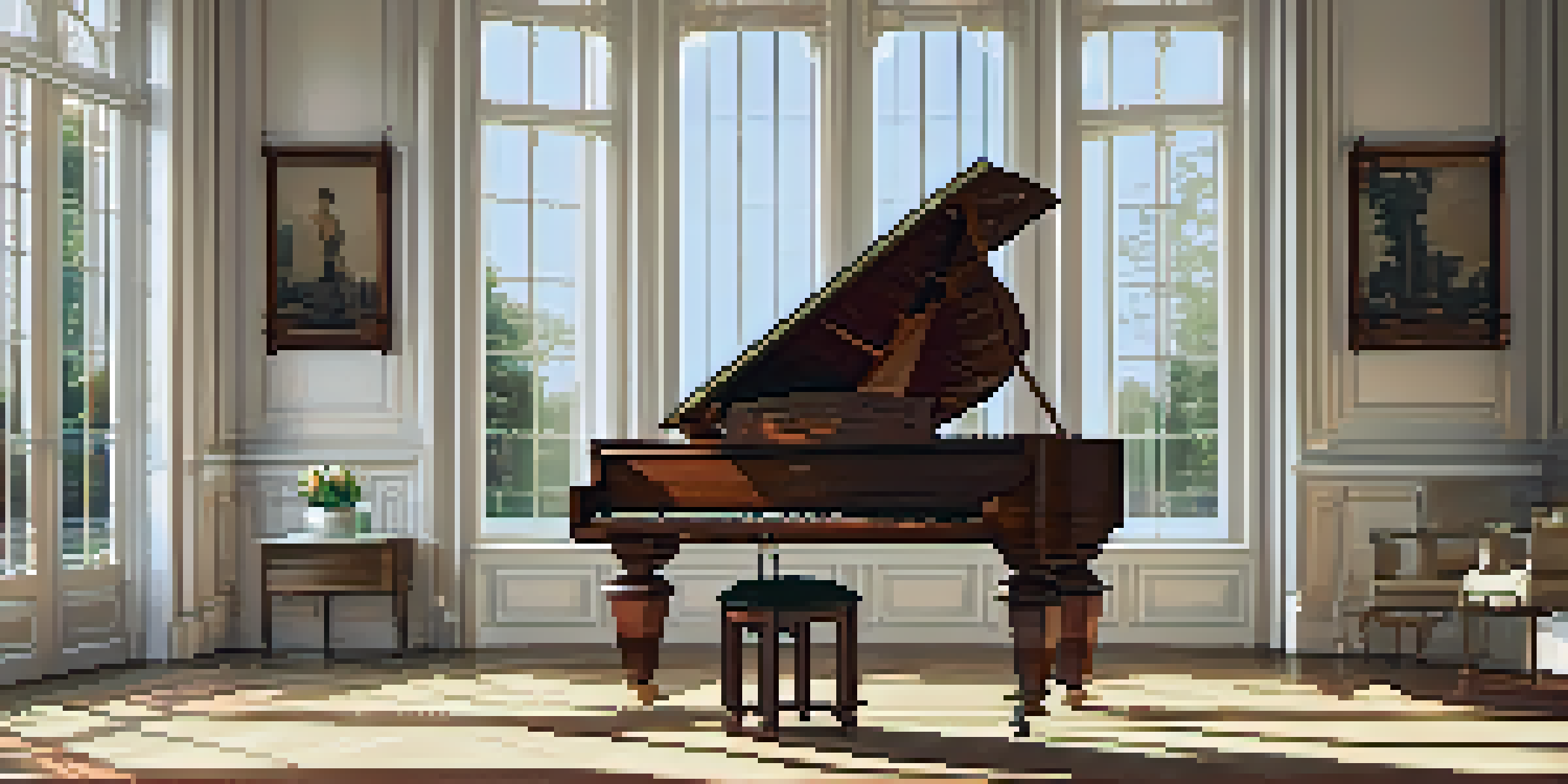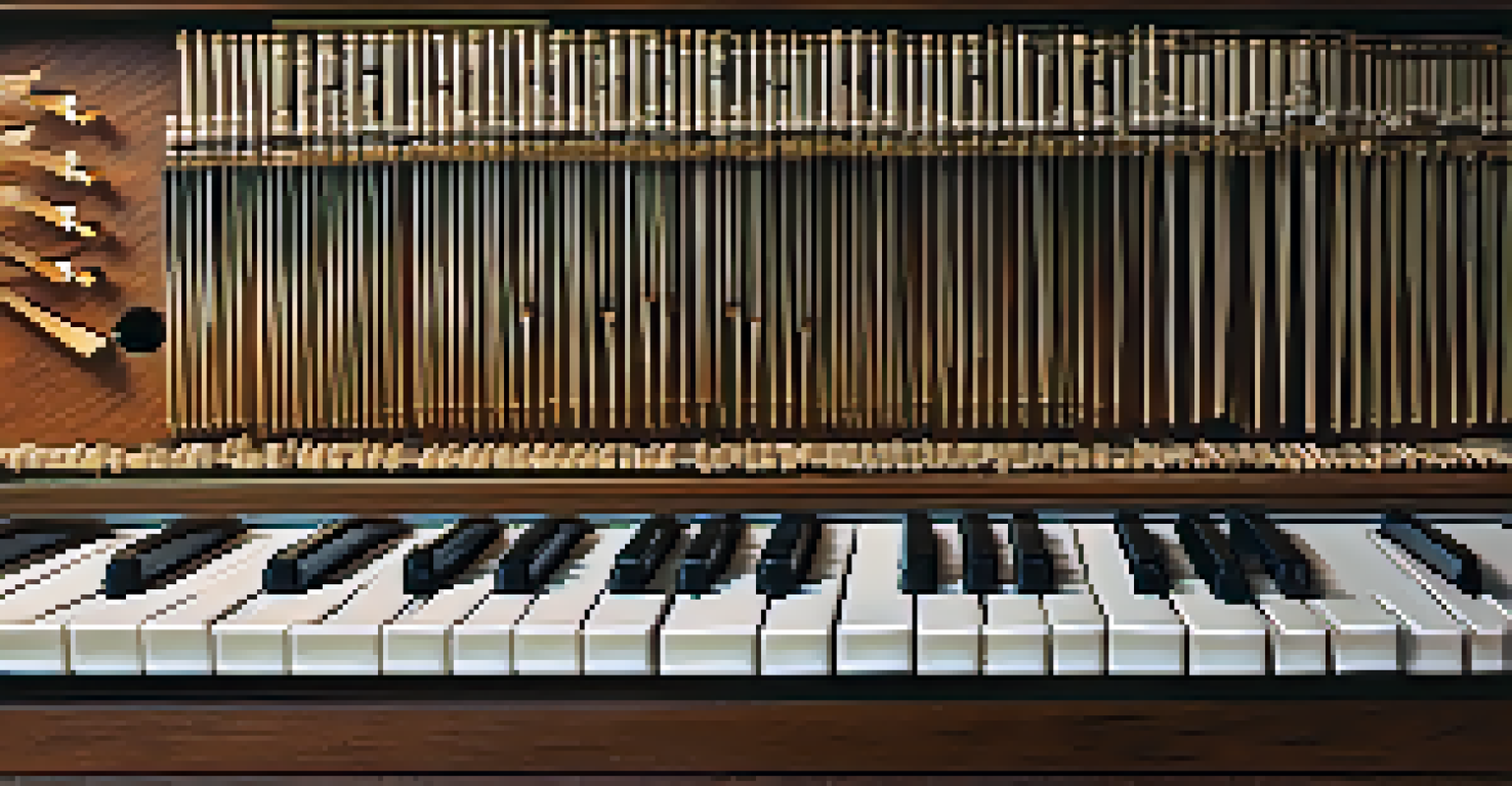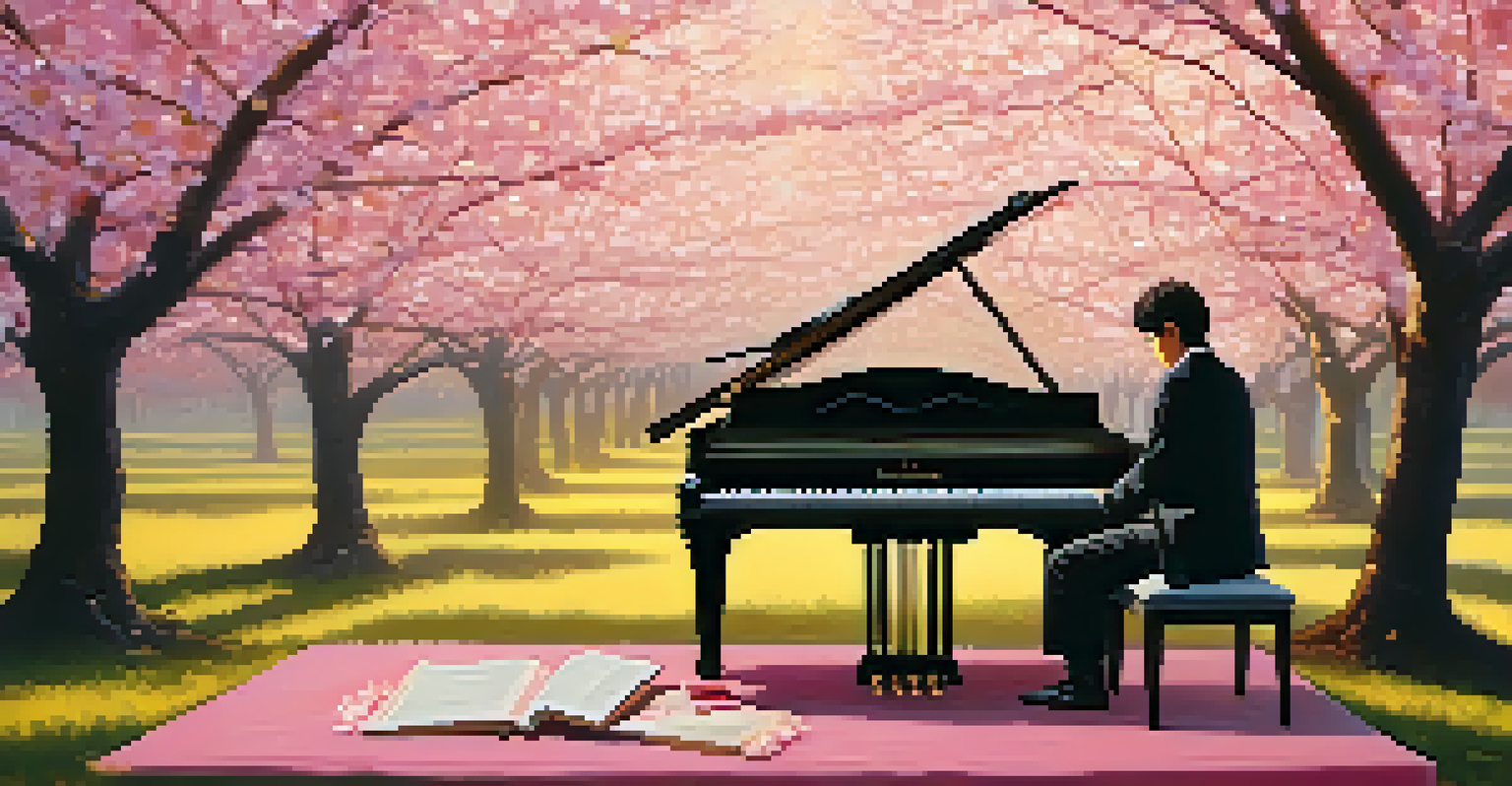The Clavichord: The Birth of Keyboard Instruments

Understanding the Clavichord's Role in Music History
The clavichord, a unique keyboard instrument, has played a pivotal role in the evolution of music. Originating in the late Middle Ages, it was one of the first instruments to allow musicians to express nuanced dynamics through touch. This capability set the stage for future keyboard instruments, making the clavichord a cornerstone in music history.
The clavichord is a sensitive instrument, one that not only conveys the music but also the soul of the performer.
Unlike the louder harpsichord, the clavichord produces sound by striking strings with metal tangents, offering a soft and intimate sound. This characteristic made it a favorite among composers and performers for practicing and composing, as it allowed for expressive playing in private settings. Its quietness is often likened to a whisper in the world of music, providing a personal connection between the player and the instrument.
As we explore the clavichord's impact, we find that it has influenced many great composers, including Johann Sebastian Bach. The instrument's ability to convey emotion and subtlety paved the way for more complex keyboard compositions, ultimately leading to the development of the piano. Understanding the clavichord's significance helps us appreciate the rich tapestry of keyboard music that followed.
The Design and Mechanism of the Clavichord
The clavichord's design is both simple and ingenious, making it accessible for both amateur and professional musicians. Typically made of wood, its compact size allows it to fit comfortably in smaller spaces, which was ideal in homes during its peak popularity. The instrument consists of a keyboard and a series of strings, with each key connected to a tangent that strikes the string to produce sound.

One of the most fascinating aspects of the clavichord is its ability to produce dynamic variations through touch. Players can control the volume and expression by adjusting the pressure applied to the keys, a feature that sets it apart from other instruments of the time. This control over dynamics is often compared to the way a painter uses different brush strokes to evoke emotion on a canvas.
Clavichord's Historical Significance
The clavichord played a crucial role in music history, enabling nuanced expression and influencing composers like Bach.
Despite its relatively quiet sound, the clavichord's unique mechanism allows for a wide range of expressive possibilities. Musicians often describe playing the instrument as a deeply personal experience, akin to telling a story through music. This intimate connection between the player and the clavichord is part of what has kept its legacy alive through the centuries.
The Clavichord's Evolution Through the Ages
The clavichord has undergone several transformations since its inception, reflecting changes in musical styles and preferences. Initially popular in the late 14th century, it flourished during the Renaissance and Baroque periods when composers began to explore its expressive capabilities. This evolution showcases the instrument's adaptability and resilience in the ever-changing landscape of music.
Every note is a whisper, a soft caress that draws the listener into a world of intimate expression.
As musical tastes shifted, so did the clavichord's design, leading to variations such as the fretted and unfretted types. The fretted clavichord, in particular, allowed for multiple notes to be played simultaneously, expanding the instrument's potential in ensemble settings. This adaptability is reminiscent of how languages evolve to accommodate new expressions and ideas.
Despite the rise of louder instruments like the piano and organ, the clavichord maintained its charm and continued to be used by various composers. Its evolution is a testament to its enduring appeal, allowing musicians to explore the depths of expression even as the musical landscape transformed around it.
Famous Composers and Their Connection to the Clavichord
Throughout history, many renowned composers have embraced the clavichord as a vital tool for their creative processes. Johann Sebastian Bach, for instance, composed numerous works for the instrument, appreciating its ability to convey intricate nuances. His love for the clavichord is often reflected in the delicate, expressive qualities of his music.
Other notable composers, like Carl Philipp Emanuel Bach and François Couperin, also recognized the clavichord's unique capabilities. They utilized the instrument to experiment with new ideas and techniques, paving the way for the development of keyboard music in the 18th century. This legacy highlights the clavichord's role as a creative playground for innovation.
Unique Design and Playing Experience
With its simple design and dynamic touch control, the clavichord offers a personal and expressive playing experience.
The connection between these composers and the clavichord underscores its importance in the evolution of Western classical music. Their works not only showcased the instrument's strengths but also contributed to a deeper understanding of musical expression. The clavichord, therefore, holds a special place in the hearts of musicians and historians alike.
The Clavichord's Place in Modern Music
In today's music scene, the clavichord may not be as mainstream as the piano or synthesizer, but it still holds a niche appeal among musicians and historians. Many contemporary composers and performers are rediscovering this instrument, drawn to its unique sound and expressive capabilities. This resurgence reflects a broader trend of embracing historical instruments in modern compositions.
The clavichord's soft tones are particularly well-suited for intimate performances and chamber music. Musicians often seek it out for its ability to create a personal atmosphere, making it a favorite among those who appreciate subtlety in sound. This intimate quality can transform a simple gathering into a profound musical experience.
Moreover, the clavichord serves as a bridge between historical and contemporary music, allowing modern musicians to connect with the past. By incorporating the clavichord into their works, artists can explore the rich textures and emotional depths that this instrument offers. In this way, the clavichord continues to inspire creativity and innovation in the world of music.
Learning to Play the Clavichord: A Unique Experience
For those interested in learning the clavichord, the experience can be both rewarding and challenging. Unlike more commonly played instruments, the clavichord demands a refined touch and an understanding of dynamic control. Beginners may find this aspect daunting, but with practice, they can unlock the expressive potential that makes this instrument so special.
Many music schools and private instructors now offer lessons focused on the clavichord, providing resources for aspiring musicians. Learning this instrument often involves exploring historical techniques and styles, which can enrich a player's overall musical perspective. This journey into the past can be likened to stepping into a time machine, gaining insights into the music of earlier eras.
Modern Resurgence and Innovation
Today, the clavichord is experiencing a revival as contemporary musicians explore its unique sound and integrate it into modern compositions.
As players become more comfortable with the clavichord, they often develop a deeper appreciation for the subtleties of music. This instrument encourages a level of mindfulness in playing, as each note requires careful attention to touch and expression. Ultimately, learning the clavichord becomes a personal journey of musical discovery and growth.
The Future of the Clavichord: Preservation and Innovation
Looking ahead, the future of the clavichord lies in a delicate balance of preservation and innovation. As interest in historical instruments continues to grow, efforts to maintain and restore existing clavichords are underway. Organizations and individuals are dedicated to keeping this unique instrument alive, ensuring that future generations can experience its beauty.
At the same time, modern musicians are finding ways to innovate with the clavichord, experimenting with new techniques and collaborative projects. By blending traditional playing methods with contemporary styles, artists are expanding the instrument's repertoire and relevance in today's music scene. This fusion of old and new is reminiscent of how cultural traditions evolve while retaining their core essence.

Ultimately, the clavichord's journey is a testament to the enduring power of music to connect us across time and space. As we continue to explore its rich history and unique sound, the clavichord will undoubtedly inspire new generations of musicians to embrace its charm and expressiveness. The future holds exciting possibilities for this remarkable instrument.